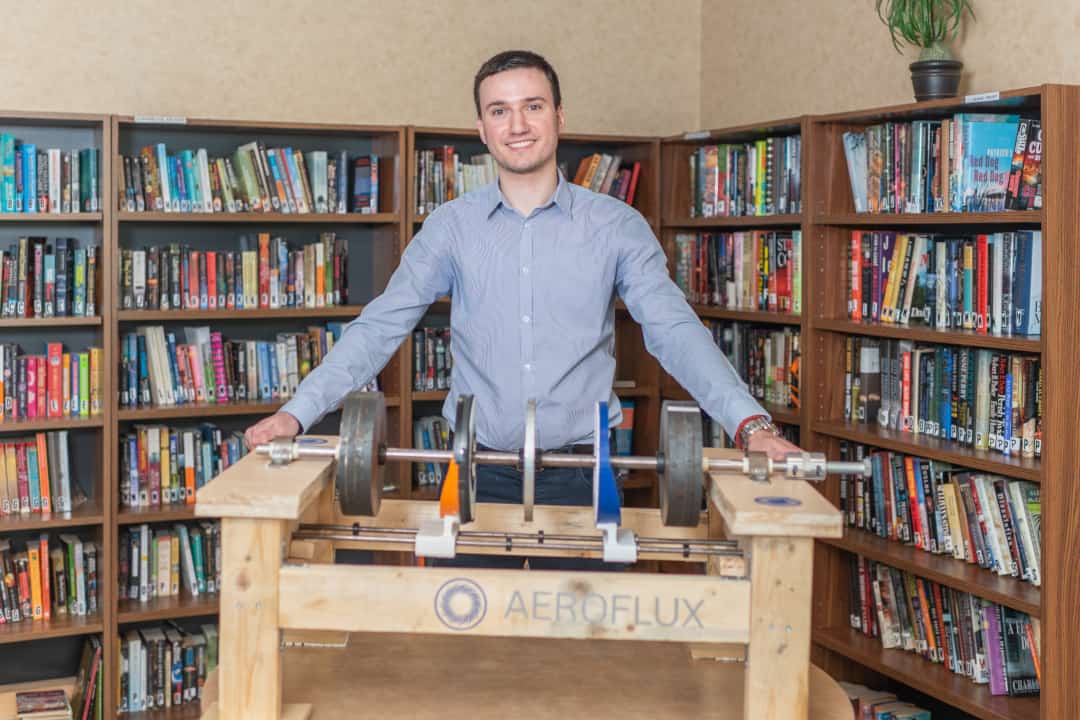The design of an innovative aircraft brake by Nikola Kostic, a recent mechanical engineering alum from the University of Toronto, has been selected as one of the top 20 finalists for the James Dyson Award (JDA).
The prestigious annual international engineering design award has been promoted in engineering design courses at U of T. It rewards a cash prize of $50,000, and the finalists’ designs are reviewed by the renowned innovator James Dyson himself.
The Aeroflux contactless brake, Kostic’s design, previously won first place at Hatchery’s demo day where its team of Nikola Kostic, together with Stevan Kostic and Roshan Varghese, received initial funding to develop their idea as a result.
How Aeroflux works
Aeroflux stops a moving object without using moving parts that may wear out.
“If you think about it, you are stopping a multi-ton aircraft without touching it. That’s really what I find fascinating about it, and what other people find interesting as well,” Kostic explained in an interview with The Varsity.
Replacing conventional brakes is a time-consuming and expensive process. Kostic’s design, however, eliminates the need for frequent brake replacements and is therefore a more sustainable solution for short-haul aircrafts. This could potentially save millions of dollars in operating costs.
The technical term for the concept used by Aeroflux is called “eddy current braking.”
It avoids wearing out mechanical parts by applying a magnetic field, which induces electric currents in the surface of a highly conductive rotor. The eddy currents then produce their own magnetic field, which opposes the stationary magnetic field that created them. This creates a braking torque on the rotor.
Kostic’s design stood out among the JDA candidates since it is an excellent example of how engineering can make an industry more sustainable, and shows commitment toward achieving the ambitious targets for greenhouse gas emissions in aviation.
“I think that now we are really just starting to see the very beginning of these solutions, which are a complete blend of engineering [and] economics, but also sustainability,” said Kostic.
Origins of Kostic’s Aeroflux design
Kostic’s idea first came to mind in his final-year engineering capstone project and was inspired by his life-long interest in aviation. During his childhood, Kostic wanted to be a pilot. His interest later shifted into aerospace engineering when he joined the mechanical engineering program at U of T.
After five years of undergraduate studies, including a Professional Experience Year, Kostic graduated last May with a Bachelor of Applied Science in Mechanical Engineering.
After graduation, Kostic decided it was the right time to jump into entrepreneurship.
“When you’re younger you can tolerate a much higher risk profile,” said Kostic. “Later in life you might have a lot more responsibilities and obligations, so I think students are kind of the ideal entrepreneurs if you choose to go that way.”
Kostic was supported by the U of T Entrepreneurship Hatchery, which granted him access to prototype funding, mentorship, and the opportunity to work with other talented students to form a strong team.
“There’s a whole network dedicated to trying to help students to create jobs for themselves,” said Kostic. “I was very lucky to have that as part of my undergraduate education and I’m very grateful for it.”
Next steps for Aeroflux
When asked about what is in store for Aeroflux, Kostic said that he plans to build a full-scale demonstrator and hopes to one day see his design on a real plane.
Kostic gave some parting advice for fellow students doing design projects.
“The [project] is what you make of it. Number one [priority] is to pick a [project] that you are passionate about, something you can really see yourself diving into. More importantly, something you can see the application for, something where you can clearly translate an academic project to a real-world solution.”


